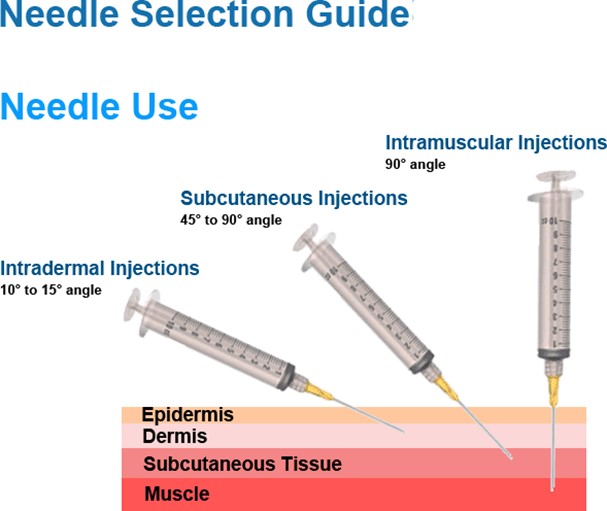A male client weighing 175 pounds is to receive an intramuscular injection into his deltoid of two milliliters (2 mL) of a viscous fluid.
Which needle size should a nurse use?
1/2 inch, 25 gauge.
1 inch, 23 gauge.
1-1/2 inches, 21 gauge.
2 inches, 16 gauge.
The Correct Answer is B
This needle size is appropriate for an intramuscular injection into the deltoid of a 175-pound adult male with a viscous fluid.
The needle length should be long enough to reach the muscle through the subcutaneous tissue, and the needle gauge should be suitable for the viscosity of the fluid. A 23-gauge needle is a common choice for intramuscular injections.

Choice A is wrong because a 1/2 inch needle is too short to reach the deltoid muscle in an adult male.
Choice C is wrong because a 1-1/2 inch needle is too long and may cause injury to the underlying nerves or blood vessels.
Choice D is wrong because a 16-gauge needle is too large and may cause excessive tissue trauma and pain.
Nursing Test Bank
Naxlex Comprehensive Predictor Exams
Related Questions
Correct Answer is A
Explanation
Notify the health care provider to report and anticipate new orders.
This is because an oral temperature of 100.8° F (38.2° C) indicates a fever, which could be a sign of infection or inflammation in an elderly client.
A fever of this magnitude could also cause dehydration, confusion, or seizures in older adults.
Therefore, the nurse should notify the health care provider as soon as possible to determine the cause and treatment of the fever.
Choice B is wrong because covering the client with an additional blanket could increase the body temperature and worsen the fever.
The UAP should not recheck the temperature in two hours, but rather monitor it more frequently and report any changes to the nurse.
Choice C is wrong because charting the temperature on the vital signs sheet and reporting to the new shift coming on is not enough to address the urgency of the situation.
The nurse has a responsibility to act on abnormal findings and communicate them to the health care provider.
Choice D is wrong because assessing the client’s temperature rectally and comparing the results is not necessary and could cause discomfort or injury to the client.
Rectal temperatures are usually higher than oral temperatures by about 0.5° F (0.3° C), so this would not change the interpretation of the fever.
The normal range for oral temperature in adults is 97.6° F to 99.6° F (36.4° C to 37.6° C).
Correct Answer is B
Explanation
The client bears weight on both feet when moving the walker ahead and steps with the weaker leg first. This is the proper way to use a walker for ambulation, as it provides stability and reduces stress on the affected joints.
Choice A is wrong because the client should not look down at his feet to prevent falling, but rather look ahead at where he is going. Looking down can cause neck strain and loss of balance.
Choice C is wrong because the client should not place her full weight on the walker with her arms while taking steps, as this can cause upper extremity fatigue and injury. The client should use the walker as a support, not a crutch.
Choice D is wrong because the client should not lean forward at a 60-degree angle while stepping into the walker, as this can cause back pain and poor posture. The client should stand upright and move the walker forward about one step’s length at a time.
Whether you are a student looking to ace your exams or a practicing nurse seeking to enhance your expertise , our nursing education contents will empower you with the confidence and competence to make a difference in the lives of patients and become a respected leader in the healthcare field.
Visit Naxlex, invest in your future and unlock endless possibilities with our unparalleled nursing education contents today
Report Wrong Answer on the Current Question
Do you disagree with the answer? If yes, what is your expected answer? Explain.
Kindly be descriptive with the issue you are facing.
